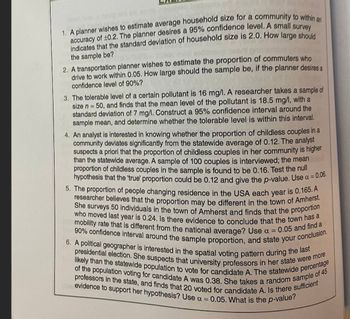
MATLAB: An Introduction with Applications
6th Edition
ISBN: 9781119256830
Author: Amos Gilat
Publisher: John Wiley & Sons Inc
expand_more
expand_more
format_list_bulleted
Question
May I know the answer and the process of Q 3?

Transcribed Image Text:1. A planner wishes to estimate average household size for a community to within an
accuracy of ±0.2. The planner desires a 95% confidence level. A small survey
indicates that the standard deviation of household size is 2.0. How large should
the sample be?
2. A transportation planner wishes to estimate the proportion of commuters who
drive to work within 0.05. How large should the sample be, if the planner desires a
confidence level of 90%?
3. The tolerable level of a certain pollutant is 16 mg/l. A researcher takes a sample of
size n = 50, and finds that the mean level of the pollutant is 18.5 mg/l, with a
standard deviation of 7 mg/l. Construct a 95% confidence interval around the
sample mean, and determine whether the tolerable level is within this interval.
4. An analyst is interested in knowing whether the proportion of childless couples in a
community deviates significantly from the statewide average of 0.12. The analyst
suspects a priori that the proportion of childless couples in her community is higher
than the statewide average. A sample of 100 couples is interviewed; the mean
proportion of childless couples in the sample is found to be 0.16. Test the null
hypothesis that the 'true' proportion could be 0.12 and give the p-value. Use a = 0.06.
5. The proportion of people changing residence in the USA each year is 0.165. A
researcher believes that the proportion may be different in the town of Amherst.
She surveys 50 individuals in the town of Amherst and finds that the proportion
who moved last year is 0.24. Is there evidence to conclude that the town has a
mobility rate that is different from the national average? Use a =
90% confidence interval around the sample proportion, and state your
6. A political geographer is interested in the spatial voting pattern during the last
presidential election. She suspects that university professors in her state were more
likely than the statewide population to vote for candidate A. The statewide percentage
of the population voting for candidate A was 0.38. She takes a random sample of 45
professors in the state, and finds that 20 voted for candidate A. Is there sufficient
evidence to support her hypothesis? Use a =
0.05. What is the p-value?
0.05 and find a
conclusion.
Expert Solution
This question has been solved!
Explore an expertly crafted, step-by-step solution for a thorough understanding of key concepts.
This is a popular solution
Trending nowThis is a popular solution!
Step by stepSolved in 2 steps

Knowledge Booster
Similar questions
Recommended textbooks for you
 MATLAB: An Introduction with ApplicationsStatisticsISBN:9781119256830Author:Amos GilatPublisher:John Wiley & Sons Inc
MATLAB: An Introduction with ApplicationsStatisticsISBN:9781119256830Author:Amos GilatPublisher:John Wiley & Sons Inc Probability and Statistics for Engineering and th...StatisticsISBN:9781305251809Author:Jay L. DevorePublisher:Cengage Learning
Probability and Statistics for Engineering and th...StatisticsISBN:9781305251809Author:Jay L. DevorePublisher:Cengage Learning Statistics for The Behavioral Sciences (MindTap C...StatisticsISBN:9781305504912Author:Frederick J Gravetter, Larry B. WallnauPublisher:Cengage Learning
Statistics for The Behavioral Sciences (MindTap C...StatisticsISBN:9781305504912Author:Frederick J Gravetter, Larry B. WallnauPublisher:Cengage Learning Elementary Statistics: Picturing the World (7th E...StatisticsISBN:9780134683416Author:Ron Larson, Betsy FarberPublisher:PEARSON
Elementary Statistics: Picturing the World (7th E...StatisticsISBN:9780134683416Author:Ron Larson, Betsy FarberPublisher:PEARSON The Basic Practice of StatisticsStatisticsISBN:9781319042578Author:David S. Moore, William I. Notz, Michael A. FlignerPublisher:W. H. Freeman
The Basic Practice of StatisticsStatisticsISBN:9781319042578Author:David S. Moore, William I. Notz, Michael A. FlignerPublisher:W. H. Freeman Introduction to the Practice of StatisticsStatisticsISBN:9781319013387Author:David S. Moore, George P. McCabe, Bruce A. CraigPublisher:W. H. Freeman
Introduction to the Practice of StatisticsStatisticsISBN:9781319013387Author:David S. Moore, George P. McCabe, Bruce A. CraigPublisher:W. H. Freeman

MATLAB: An Introduction with Applications
Statistics
ISBN:9781119256830
Author:Amos Gilat
Publisher:John Wiley & Sons Inc

Probability and Statistics for Engineering and th...
Statistics
ISBN:9781305251809
Author:Jay L. Devore
Publisher:Cengage Learning

Statistics for The Behavioral Sciences (MindTap C...
Statistics
ISBN:9781305504912
Author:Frederick J Gravetter, Larry B. Wallnau
Publisher:Cengage Learning

Elementary Statistics: Picturing the World (7th E...
Statistics
ISBN:9780134683416
Author:Ron Larson, Betsy Farber
Publisher:PEARSON

The Basic Practice of Statistics
Statistics
ISBN:9781319042578
Author:David S. Moore, William I. Notz, Michael A. Fligner
Publisher:W. H. Freeman

Introduction to the Practice of Statistics
Statistics
ISBN:9781319013387
Author:David S. Moore, George P. McCabe, Bruce A. Craig
Publisher:W. H. Freeman